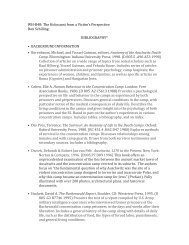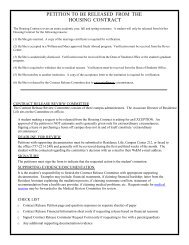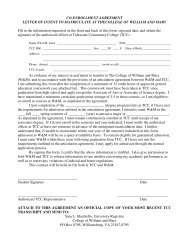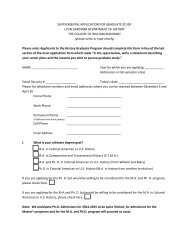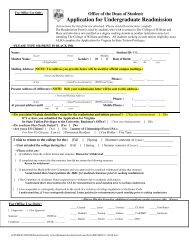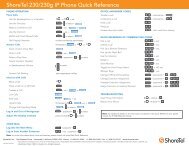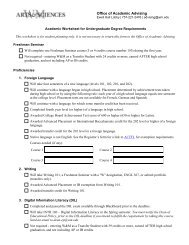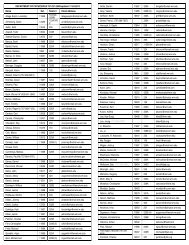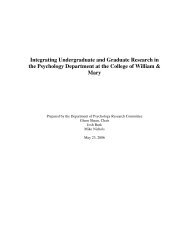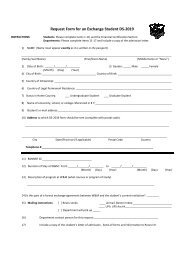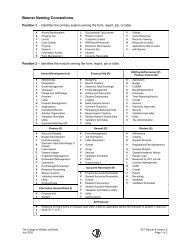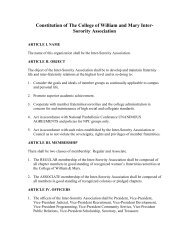Course Selection Guidebook [pdf] - College of William and Mary
Course Selection Guidebook [pdf] - College of William and Mary
Course Selection Guidebook [pdf] - College of William and Mary
You also want an ePaper? Increase the reach of your titles
YUMPU automatically turns print PDFs into web optimized ePapers that Google loves.
<strong>Course</strong> <strong>Selection</strong> <strong>Guidebook</strong> – Fall 2011opportunity for students in this course to apply for positions in CHEM 191 (Freshman HonorsResearch). Applications are made at the beginning <strong>of</strong> the fall term. Students selected for thisprogram become immediately involved in research though collaboration with a selected facultymember. Students with exceptional laboratory backgrounds <strong>and</strong> planning to major in chemistrymay also have the opportunity to begin research through CHEM 291 (Chemical Research). ContactDr. J.C Poutsma, Director <strong>of</strong> Undergraduate Studies in Chemistry, (jcpout@wm.edu or 757-221-2548) if you would like more information regarding research opportunities within the department.Students with exceptionally strong high school chemistry backgrounds that did not receive AP orIB credit may also consider taking an examination administered by the department at the beginning<strong>of</strong> the fall semester. This exam is similar in length <strong>and</strong> scope to final exams in CHEM 103.Syllabi for CHEM 103 may be found on the department website athttp://www.wm.edu/as/chemistry/index.php. Students passing the exam will be awarded credit forCHEM 103 <strong>and</strong> 103L, <strong>and</strong> they will be allowed to enroll in CHEM 335 <strong>and</strong> apply for positions inCHEM 191. Contact Dr. Chris Abelt, the department chair, at 757-221-2540 or cjabel@wm.eduprior to your arrival for fall orientation if you are interested in this option <strong>and</strong> would like toschedule an examination time.The chemistry curriculum has a hierarchical structure <strong>of</strong> courses. For this reason studentsconsidering a major in chemistry should enroll in CHEM 103 <strong>and</strong> 103L in the fall <strong>and</strong> CHEM 206<strong>and</strong> 206L in the spring <strong>of</strong> their freshman year (CHEM 335 <strong>and</strong> CHEM 206 for those with APcredit). MATH 111 <strong>and</strong> 112 (Calculus) should also be taken over the freshman year as well if noAP credit has been awarded. Those considering other science majors may also want to considerenrolling in CHEM 103 <strong>and</strong> 206 in their first year as well.For more information, please contact the Department at 757-221-2540 or visit our web siteat http://www.wm.edu/as/chemistry/index.php.Introductory <strong>Course</strong>s <strong>of</strong>fered only in the Fall semester101: Survey <strong>of</strong> Chemical Principles - (GER 2A) Fall (3) General chemical principles related tohumans <strong>and</strong> their environment, including the composition <strong>of</strong> matter, chemical reactions, <strong>and</strong>energy. Designed for nonscience majors. CHEM 101L is the companion laboratory course.(Science majors <strong>and</strong> pre-medical students should enroll in CHEM 103 instead <strong>of</strong> 101.)103: General Chemistry I - (GER 2A) Fall (3) A study <strong>of</strong> the nature <strong>of</strong> atoms <strong>and</strong> molecules,stoichiometry, states <strong>of</strong> matter, solutions, reactions, kinetics, <strong>and</strong> equilibrium. For science majors<strong>and</strong> premedical students. CHEM 103L is the companion laboratory course.101L: Chemical Principles Laboratory – (GER 2A laboratory) Fall (1) Laboratory techniques inchemistry for non-science majors. This course consists <strong>of</strong> a one-hour discussion period early inthe week followed later by a three-hour laboratory. Students taking this course should be enrolledconcurrently in CHEM 101.103L: Chemistry Laboratory I (General) - (GER 2A laboratory) Fall (1) Laboratory techniques inchemistry. The course consists <strong>of</strong> a one-hour discussion period early in the week followed later bya three-hour laboratory. Students taking this course should be enrolled concurrently in CHEM 103.33


![Course Selection Guidebook [pdf] - College of William and Mary](https://img.yumpu.com/46952524/33/500x640/course-selection-guidebook-pdf-college-of-william-and-mary.jpg)
